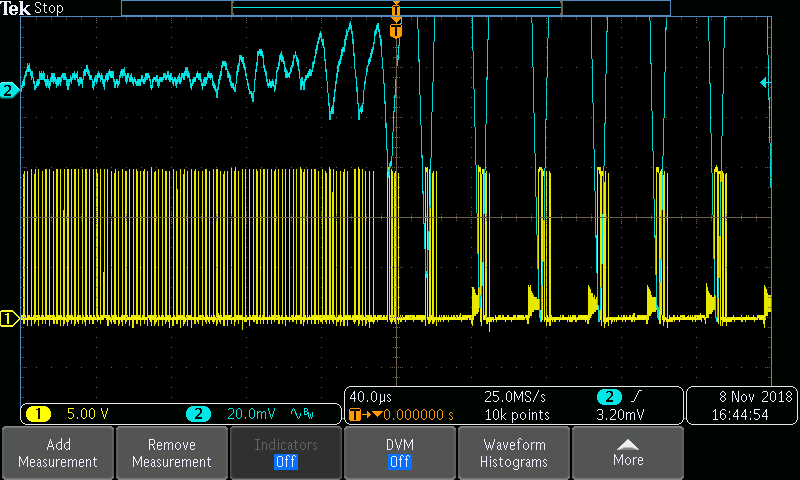Other Parts Discussed in Thread: , , TPS562201, TPS54308, TPS54339, TPS54239
We are considering the TPS54202 for a new design where we will need four of them, each running from a 15V rail and producing 5V, 3.3V, 1.5V and 1.35V. We have bought several of the TPS54202EVM-716 board to experiment with but are having difficulty getting stable behaviour with the 1.35V output (we are yet to try 1.5V).
The 1.35V rail needs to operate from near 0A load up to around 1.5A.
Initially we took the EVM and experimented with the default 5V setting. We then replaced the lower divider resistor with a 78.7k and 348R in series to produce our 1.35V output, leaving the higher than needed 15uH inductor. The output capacitors 2x22uF match our design (if anything at 1.35V we will have higher capacitance than the dev board would have had at 5V DC bias). We also changed the feed-forward capacitor to 15pF.
The behaviour we are seeing is that:
- With no load the ripple seems reasonable - a 20mV kick every 1 second or so with the pulse skipping mode active
- From 0A load, ramping up to 300mA we see the ripple ramp up with the load to 112mV
- Ramping up the load to 2A we see this increase with load up to about 350mV ripple
- Switching the PSU off and back on with the 2A load present the ripple is <20mV - much cleaner
- From this point reducing the load in 100mA steps the ripple remains around 20mV until we get to 0.5A when it suddenly jumps up to 350mV
- The ripple retains this higher level regardless of where the current load is changed
- Only powering on with the load present and >1.2A gives the lower ripple
This seems like a stability problem - the resulting ripple is not an excessive oscillation but clearly more than we should expect. It also appears with load steps. Sometimes we see low ripple at 20mV then randomly it jumps to 350mV.
We have the same behaviour with the TPS54202H (non spread-spectrum) and when we change the feed-forward capacitor or load capacitance it doesn't seem to make much difference. Increasing the load cap brings the ripple down, naturally, but still more than we can tolerate and this two-state behaviour is not cured. We have also changed the inductor to our calculated value of 4.7uH.
We are have performed stability bode plots which show around 40 degree phase margin, but we are still characterising our test setup and isolation transformer for this measurement. We are working on improving our confidence in this measurement.
I would appreciate any pointers on where we may need to go with this. Ultimately the PSU will be connected to a processor with load step changes, a lot of board distributed capacitance for decoupling. I need to make sure this is a good choice of IC. Alternatively the TPS562201 works perfectly for us but we wanted more head-room on the input voltage.
Kind regards,
Mark


